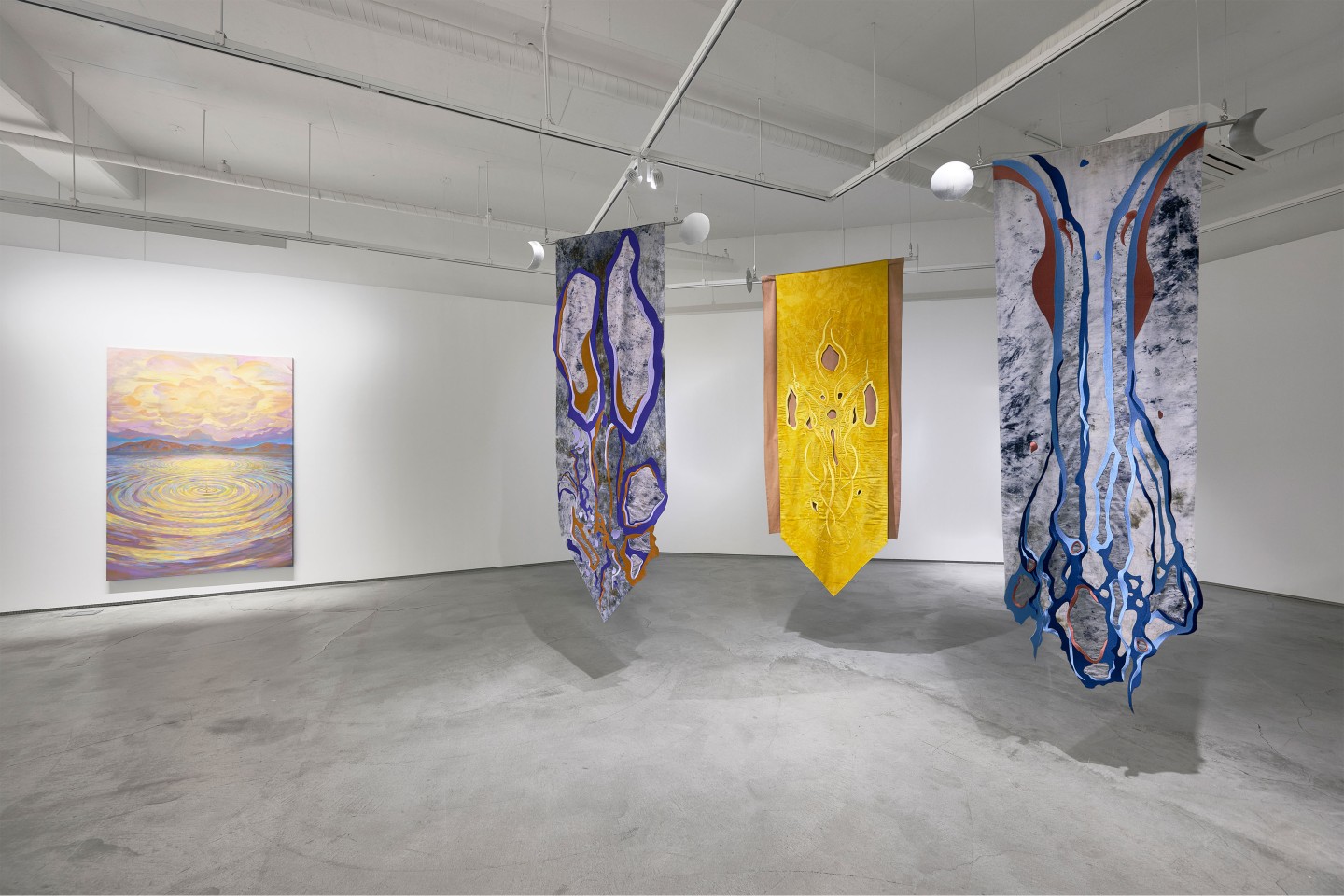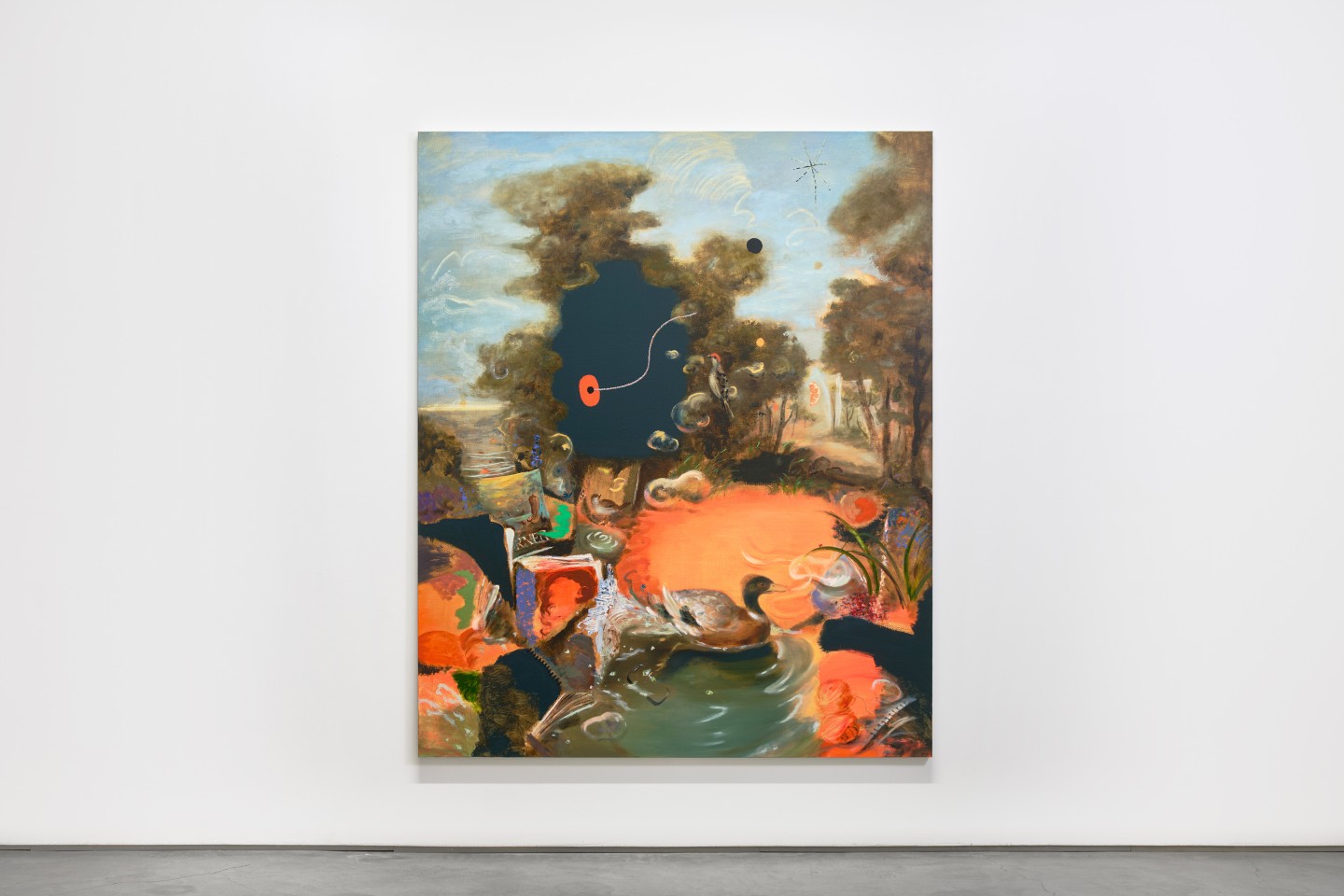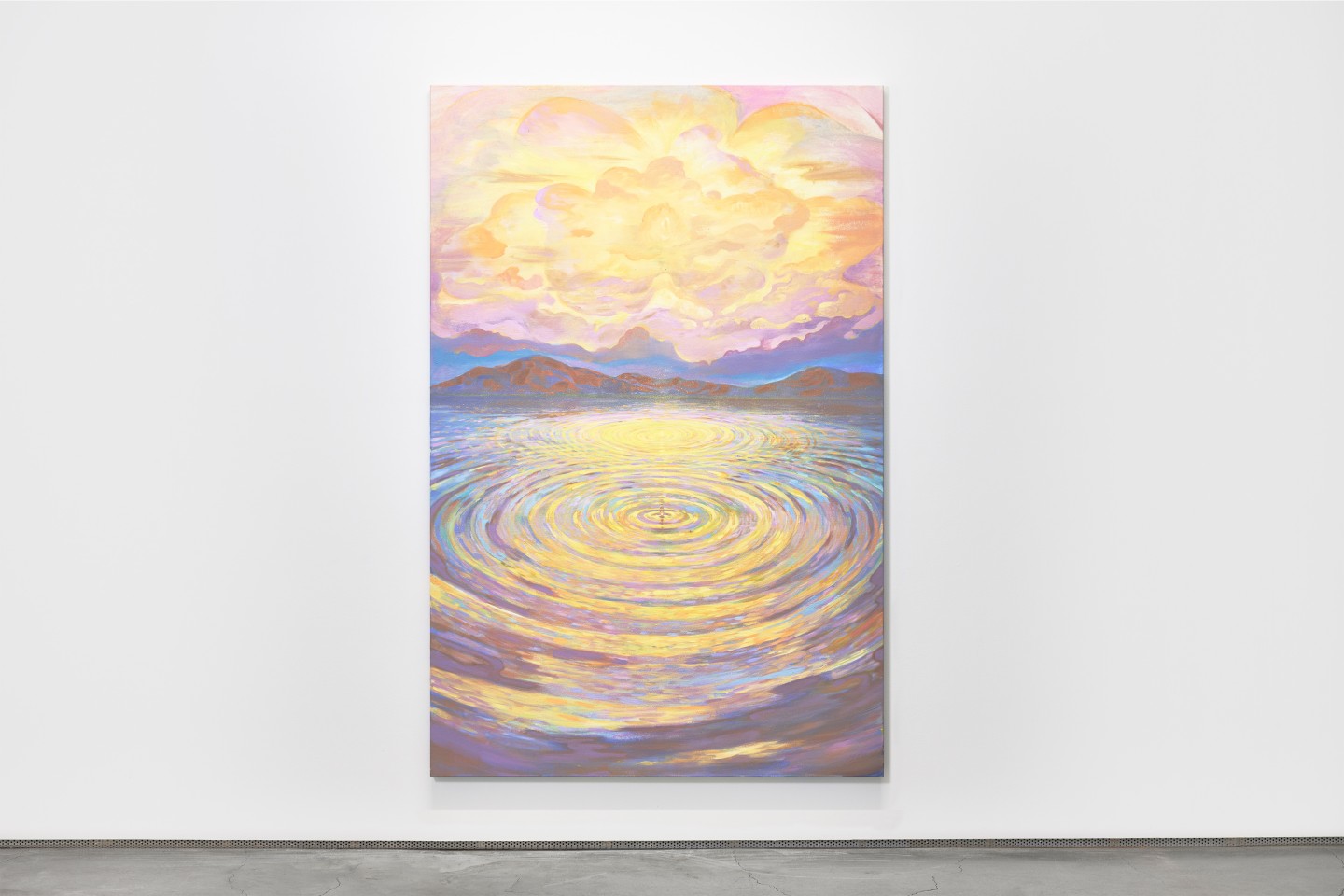Exhibition
The Mutable Line

INSTALLATION VIEW “The Mutable Line”, 2025. Courtesy of the Artist and G Gallery.
One day in Paju, we (Choi Sujin and I) sat across from each other and spoke of the sounds coming from afar. As our conversation continued, the boundary between “here” and “there” became increasingly vivid—a line never directly felt, yet sharply present. That word—boundary—led me to the reason behind how the images scattered across Choi’s works found their way into the rectangular bounds of her paintings. They are drawn from memories of different times and places, but a connection so delicate, like the thinnest of threads, brings them together to form an endless chain. In tracing these memories, moments from today, yesterday, and the distant past easily converge into a single scene. It is not uncommon to find a fragment of yesterday sitting next to one from long ago. These fragments—ranging from nights echoing with propaganda and K-pop, to Henri Rousseau’s The Sleeping Gypsy, and moments of stillness pierced only by the faint chirping of insects—are stitched together by a deeply personal, intuitive logic. But their resonance lies in how they borrow the strength of shared images, inviting viewers to form their own associations and step easily across that seemingly sharp line.
It is a line that is at once firm and fluid.
Camilla Alberti once remarked that perhaps villains–monsters–aren’t always evil. She admitted to feeling more drawn to them, which I naturally acknowledged with neutrality, without a second thought. The division between you and me becomes stark when our sense of right and wrong diverges. Boundaries gain clarity and solidity through such dichotomies—growing into tall, impenetrable walls. But from doubt and resistance toward fixity, the boundary begins to waver. It unravels, shifts, and reconfigures. Like a banner at the front of a procession, it signals the possibility of a different path, swaying and leading change. The boundary, once rigid, flutters like a flag, suspending the line between self and other, human and nonhuman, order and chaos. It becomes a symbol of hybridity—fluid and continually entangled.
Some boundaries are not drawn as stark lines but exist as wide, hazy planes with no discernible edge.
On this surface-not-line hides an infinite state of potential. Haevan Lee directs her gaze towards the landscape found upon it, yet it is far, blocked, and out of reach. Her past has circled the peripheries of these borders, traversing countless visible and invisible lines, both near and distant. All is denied save the act of memorialization within the wide, static boundary that divides South and North Korea. It remains a vacuum state between the differences of “here” and “there”. Lee now departs from the moments spent hovering at the edge of this harsh border and travels easily across lines that may be crossed in a single step; in the blink of an eye. Through constant encounters with horizontal and vertical borders, distant points thought to be unreachable are unexpectedly brought into sharp focus. These unapproachable, yet ultimately inescapable zones reveal themselves as blurred temporal spaces, where the tension and vigilance from both sides quietly dissipate.
From the firmly drawn to the faintly fading, we find ourselves reimagining the boundary in all its layered forms. Sometimes distinct, sometimes elusive, sometimes visible, sometimes symbolic—it is a line that reveals absence through presence, and evokes presence through absence. This shifting threshold resists binary thought, navigating between clarity and ambiguity through sensory exploration. Haevan Lee, Choi Sujin, and Camilla Alberti each approach the boundary differently—drawing it, erasing it, reshaping it not as a line but a surface; presenting the possibility of connection and fluidity instead of separation and rigidity. Their works remind us that the borders surrounding us are not immutable lines but mutable terrains—forever shifting, entangling, and unfolding into new spaces for perception and connection.
Haevan Lee (B. 1990) is a contemporary artist whose practice investigates the geopolitical landscapes of borders and buffer zones across the globe. Her practice, which spans painting, installation, and video, combines storytelling and historical research to examine the complexities of border politics, ecological entanglements, and ideologically confined environments. Lee captures the regional contexts of specific sites while exploring the sublime of nature that persists in the aftermath of disaster. Research forms the foundation of her imaginative and painterly inquiries.
Choi Sujin (b. 1986) constructs painterly spaces based on places and moments encountered during walks and travels, layering sensory impressions, memories, experiences, and imagined imagery. Her work evokes dreamlike, disjointed scenes where the conventional logic of time and space dissolves. She develops spatial depth and narrative complexity by unfolding these layered traces of memory and internal reflections across the canvas. In recent works, she observes her domestic environment and surrounding ecosystems, integrating bodily rhythms and temporal perception accumulated through daily repetition into landscapes that merge the personal and the external.
Camilla Alberti (b. 1994) creates alternative scenarios for coexistence and collaboration among multiple species, challenging anthropocentrism through her practice. Drawing from ancient technologies and alchemical methods, she collects and experiments with discarded or readily available natural materials. By exploring material transformations such as drying, decay, and staining, she visualizes the organic network structures in which all beings are entangled—even at the cellular level. Grounded in a non-human-centric perspective and an awareness of complex interconnections between entities, Alberti seeks to reconfigure modes of perception that move fluidly between the microscopic and the macroscopic.

INSTALLATION VIEW “The Mutable Line”, 2025. Courtesy of the Artist and G Gallery.
어느 날 우리(나와 최수진)는 파주에 마주 보고 앉아 멀리서 들려오는 소리에 관한 이야기를 나누었다. ‘저 멀리’와 ‘여기’를 가르는 경계는 이야기를 나눌수록 선명해졌다. 그것은 직접 감각한 적 없지만 매우 뚜렷하게 존재하는 선이다. 그리고 튀어 올라온 경계라는 단어는 최수진의 작품 안에 그려 모아져 있던 이미지들이 네모난 화면 안으로 들어오게 된 이유로 이끌어 주었다. 최수진의 기억 속 서로 다른 시간과 장소에서 불려 왔지만 아주 작은 실마리와도 같은 연결이 끊임없이 이어진다. 기억을 더듬어 탐색할 때, 오늘과 어제 그리고 먼 과거가 하나의 장면으로 합쳐지거나, 어제의 한 조각 옆에 먼 과거의 다른 조각이 붙어 있곤 한다. 조각들은 멀리서 대북 방송과 K-pop이 들려오는 밤의 풍경에서부터 앙리 루소의 〈잠자는 집시〉로, 풀벌레 소리가 들리는 것 같은 고요함으로 이어진다. 매우 주관적인 연결고리는 보편적 이미지가 갖는 힘을 빌려 보는 이로 하여금 그만의 연결을 짓게 하고 선명한 경계 안으로 쉬이 들어오게 만든다.
그것은 매우 분명한 선이며 또 매우 유연한 선이기도 하다. 카밀라 알베르티의 악당이 꼭 나쁜 것만은 아닐 수도 있지 않냐는 말과 악당에게 더 이끌린다는 말은 다른 선택지 없이 그럴 수도 있지란 답으로 이어졌다. 너와 나를 나누는 것은 나와 너의 옳고 그름이 다른 방향을 향하고 있을 때 선명하게 드러나는 일이다. 경계는 둘 사이를 가르는 이분법으로부터 선명함과 견고함을 획득하고 마치 높고 긴 담벼락처럼 굳건해진다. 그러나 고정된 상태에 대한 의심과 거부로부터 경계는 끊임없이 흔들리고, 해체되며, 재구성된다. 그것은 마치 행렬의 선두에 선 긴 장대에 매달린 깃발(banner)처럼 뒤따르는 선을 움직이며 바뀔 가능성에 앞장선다. 고정된 개념에 관한 질문을 던지며 끊임없이 흩트려 내는 깃발의 모습을 한 경계는 너와 나, 인간과 비인간, 질서와 혼돈 사이의 선을 유예하며, 언제든 다시 섞이고 연결될 수 있는 유동적이고 혼종적인 상태의 상징이 된다.
어떤 경계는 얇고 선명한 선이 아니라, 어디가 끝인지 모를 넓고 흐릿한 면적이다.
경계라는 선이 아닌 면 위에 숨겨진 무한한 상태가 있다. 이해반은 그 면적 속 풍경으로부터 가로막힌 채 멀리 떨어져 다가갈 수 없는 지점을 응시한다. 이해반이 지나온 시간은 경계의 주변을 맴돌았고, 바로 위로 때로는 저 멀리 있는 수없이 많은 선들을 넘나들었다. 기억으로 남기는 것 외에 모든 것이 가로막힌 남쪽과 북쪽을 가르는 너른 경계는 이쪽과 저쪽의 다름 사이에서 정지된 진공상태로 머문다. 이제 근접조차 할 수 없는 경계의 주변에서 머물렀던 때에서 떠나 한 걸음 혹은 순식간에 쉬이 지나가 버릴 수 있는 선을 넘나든다. 수평적, 수직적 경계를 끊임없이 감각하며 오히려 도달할 수 없는 지점을 더욱 선명히 떠올린다. 이렇게 쉽게 다가갈 수 없지만 또 끝내 외면할 수 없는 진공의 시공간은 양쪽에서 뿜어내는 긴장과 경계심마저 멈춰내고야 마는 흐릿한 지점임을 인식한다.
때로는 견고하고, 때로는 변화하며, 또 때로는 흐릿해지는 경계와 기준의 안과 밖에서 우리는 경계가 가질 수 있는 다양한 층위를 떠올리게 된다. 그것은 선명하거나 모호하고, 가시적이거나 상징적일 수 있다. ‘없음’을 통해 ‘있음’을 드러내고, ‘있음’을 통해 ‘없음’을 감각하게 만드는 이 유동적인 선은 고정된 기준과 이분법을 넘어서는 시도이자, 분명함과 흐릿함 사이를 오가는 감각적 탐색이다. 이해반, 최수진, 카밀라 알베르티는 각기 다른 방식으로 경계의 형태를 그리고, 지우며, 선이 아닌 면, 고정이 아닌 유동, 단절이 아닌 연결의 가능성을 제시한다. 이로써 우리를 둘러싸고 있는 수많은 경계는 결코 고정된 선이 아니며, 언제든 다시 흔들리고 섞이며, 새로운 감각과 해석의 공간으로 확장될 수 있음을 환기한다.
이해반(B.1990)은 경계와 완충지대의 지정학적 풍경을 회화적 연구의 형식으로 탐구한다. 그는 국경 정치의 복잡성과 생태 환경을 이해하기 위해 풍경화, 스토리텔링, 역사 연구를 활용하며, 회화, 설치, 비디오 등 다양한 표현형식을 통해 특정 장소의 지역적 맥락을 포착한다. 국경의 풍경, 이데올로기적으로 제한된 물리적 환경과 자연 등에 대한 관심과 리서치를 바탕으로 예술가적 상상을 펼치고, 회화적 연구를 전개하고 있다.
최수진(B.1986)은 여행이나 산책에서 마주친 장소와 상황을 바탕으로 회화적 공간을 그리며, 누적된 감각, 기억, 체험, 환상의 이미지를 조합해 화면을 구성한다. 한순간에 빨려 들어가는 듯한 꿈속과 같은 이질적인 세계를 화면 위로 옮기며 시공간의 질서가 해체된 장면을 그려 나간다. 기억의 잔상과 마음속 상념들이 켜켜이 쌓인 층위를 한 번에 펼쳐 놓음으로써 회화적 공간감과 서사의 구조를 구축해 나가고 있다. 최근에는 집과 주변 생태계를 관찰하고 반복되는 일상에서 각인된 신체 감각과 시간 감각을 사적 공간 혹은 풍경에 함께 녹여낸 화면으로 구성하고 있다.
카밀라 알베르티(B.1994)는 여러 종의 공존과 협업을 위한 대안적 시나리오를 생성해 나가며 인간중심주의에 도전하는 작업을 이어간다. 고대 기술 및 연금술적 실천을 참조하여 버려진 혹은 주변에서 쉽게 구할 수 있는 자연 재료들을 수집하고, 실험하는 과정을 이어 나간다. 건조, 부패, 얼룩과 같은 물질의 상태 변화를 탐구함으로써, 모든 존재가 세포 단위에서부터 얽혀 있는 유기적 네트워크 구조를 시각화하고자 한다. 알베르티는 존재 사이의 복잡한 상호 연결성과 비인간 중심주의적 시각을 바탕으로, 미시적 시야와 거시적 관점을 넘나드는 인식의 지형 전환을 시도한다.

INSTALLATION VIEW “The Mutable Line”, 2025. Courtesy of the Artist and G Gallery.
2025. 06. 25. (Wed) – 07. 26. (Sat)
G Gallery